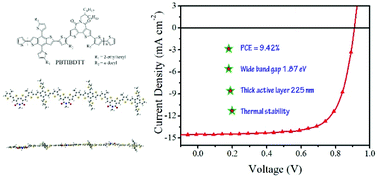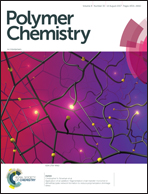Novel wide band gap copolymers featuring excellent comprehensive performance towards the practical application for organic solar cells†
Abstract
In the past few decades, extensive efforts have been devoted to improve the power conversion efficiencies (PCEs) of organic solar cells (OSCs), while their comprehensive performance including high efficiency, fulfilling the prerequisites of solution printing technology (active layer thickness >200 nm) and long-term thermal stability, which are essential for the practical application of OSCs, have not been paid adequate attention yet. In this communication, two novel wide band gap (WBG) polymers of PBTIBDTT and PBTIBDTT-S were designed and synthesized. PBTIBDTT devices exhibit a high PCE of 9.42%, which is one of the highest values reported for OSCs fabricated from WBG materials and the PCEs could remain above 8.6% as the active layer thickness further increased to 280 nm. More importantly, the device displays remarkable thermal stability for 120 hours at 100 °C. To the best of our knowledge, this is the first time to report a WBG material that features excellent comprehensive performance, which would open a new avenue to design meaningful conjugated copolymers towards future practical applications.



 Please wait while we load your content...
Please wait while we load your content...